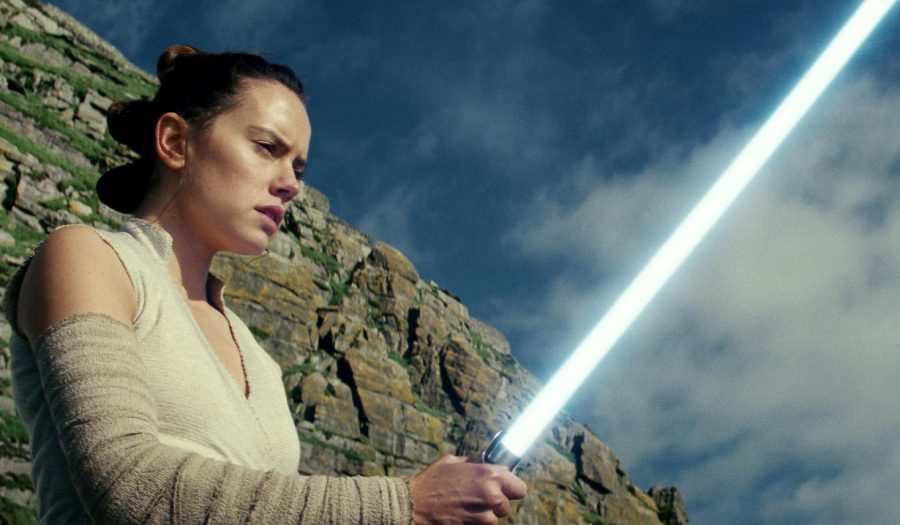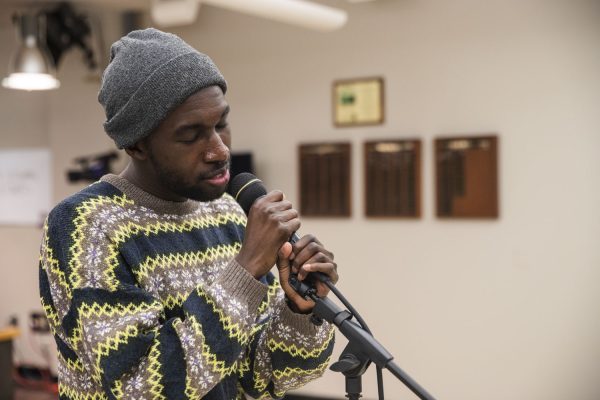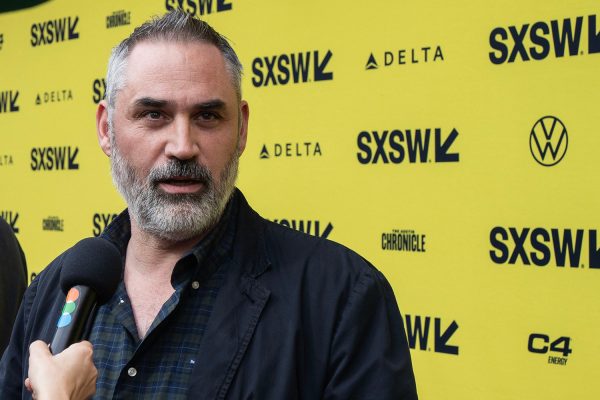The power of the force: The end of the Star Wars saga is nearly here
‘A New Hope’ first debuted in 1977, bringing with it a revival of space opera and innovative storytelling and special effects. 42 years later, ‘The Rise of Skywalker’ marks an end to the space opera series with a diverse cast of more complex characters.
“Star Wars: The Last Jedi” begins where “The Force Awakens” left off, with Rey (Daisy Ridley) having tracked down Luke Skywalker. [Walt Disney Pictures]
Bright blue letters fade into the dark screen, readying audiences with its preliminary, “A long time ago, in a galaxy far, far away…” Members of this multi-generation audience sit with bated breath, waiting for the soaring sound of the first note in the Star Wars main title theme song.
On Dec. 20, thousands of people will bear witness to the end of a saga whose reign has captivated audiences, shaped pop culture and science fiction since 1977. With fans of all ages anticipating The Rise of Skywalker, the ending of the saga shows how drastically times have changed, and how innovative special effects and in-depth world building caused Star Wars to be such a success.
However, the idea of Star Wars originated from other content, as all movies do. George Lucas was highly influenced from re-printed copies of Pulp magazines from the ‘30s, according to Peter Balestrieri, curator of Science Fiction & Popular Culture at University of Iowa Libraries. The saga places itself under a genre of science fiction called space opera, where a big adventure happens with evil emperors, princesses, and heroes, all fighting a war going on in outer space.
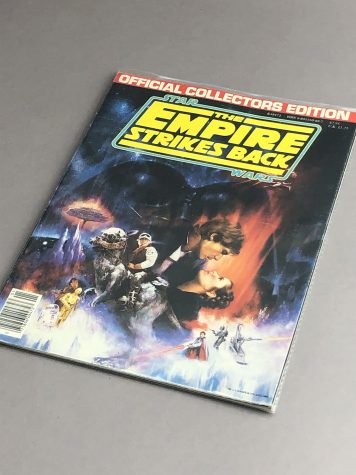
“Lucas brings space opera back,” Balestrieri said. “What happens is that everybody that goes to see it gets a heavy dose of the space opera they’ve maybe never experienced before. Star Wars revives a cultural interest in space opera that leads to all kinds of new films, most of them of poor quality, but it’s a revival that has lasted.”
The success of Star Wars led to the creation of new Star Trek films, Balestrieri said, though he adds that the original trilogy trails back to the story of Flash Gordon, a space opera comic strip that debuted in 1934.
“The major impact that I think Star Wars has is this continuing cultural interest and cultural experience with space opera,” Balestrieri said.
After the prequel Star Wars films made in the early 2000s, the series remained stagnant until Lucas sold the rights to Disney, allowing the company to make the next film in the saga. Disney and other big corporations buy these films to not only draw in millions but to make a profit out of the merchandise.
“Disney has been about marketing since the earliest days of Mickey Mouse cartoons that Walt was drawing himself,” Balestrieri said.
When A New Hope hit theaters in 1977, it stunned audiences with its innovative and high standard special effects for the time, Balestrieri said.
“There’s a tipping point in terms of quality for special effects,” said Kembrew McLeod, a Professor of Communication Studies who studies popular culture at the UI and is an independent documentary filmmaker. “It was really the first science fiction film that looked pretty realistic, as opposed to looking like, you know, model spaceships hanging from invisible threads.”
Like many successful sci-fi and fantasy movies, Star Wars captures its audience with in-depth world-building.
“We don’t just meet this character, we find out about this character’s background,” Balestrieri said. “Not everything is revealed in that first film; we keep learning about the characters throughout the trilogy.”
The characters are seen talking about the Empire, the Resistance, and the Republic, presenting the audience a sense of that various galaxies are connected either through war or business.
“Lucas has the ability, through extensive world-building, to shift around in time and space,” he said. “He keeps giving you more and more information about this universe and all the people in it; that’s very satisfying to science fiction and fantasy audiences.”
Related: Austin’s Arcade: The Force is strong with Star Wars Jedi: Fallen Order
Despite its initial and continuing success, the original trilogy was flawed in the most visible way possible: it lacked representation of ethnicity, race, and gender.
“One of the things that hampered the original films was that it was a product of its era,” McLeod said. “It was a product of a time when protagonists of films like that were almost exclusively white and male.”
Even though the audience sees African-Americans being represented in Lando Calrissian (Billy Dee Williams), his character is still far from being a major role. While Princess Leia is often seen as a brave heroine, she is at first seen as a damsel in distress and in need of rescuing from the grasp of Darth Vader.
Princess Leia is assertive once rescued, but she still lacks the kind of driving force behind the plot, McLeod said.
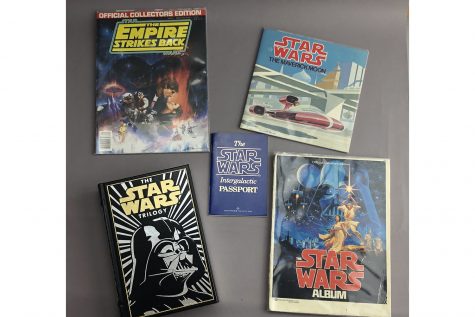
Having cast the first African-American male lead (John Boyega) as Finn, a former storm trooper who left the evil First Order, and the first female driving lead (Daisy Ridley) as Rey, a former scavenger and now a Jedi Knight, the latest films have improved drastically with regards to representation.
“I think there’s been care on the part of the filmmakers to make sure that race and gender are represented in different ways,” Balestrieri said. “But having said that, do we have any trans characters? Do we have any gay or lesbian characters? Not yet. Maybe the last film will introduce some.”
UI student Abby Knipfel says that even with the clones (Temuera Morrison) and Mace Windu (Samuel L. Jackson) in the prequel series, the diversity still wasn’t there.
“God bless the prequels, but aside from the clones and Mace Windu, who gets straight up murdered, there wasn’t a ton of diversity in those films,” she said. “The sequels are definitely better.”
Knipfel thought this may be a Star Wars nitpick; the new movies focus too much on the human characters and don’t have enough alien ones.
Rogue One is perhaps the most 21st Century-esque of all the Star Wars movies, not only because of its diverse cast, but also because of the absence of romance within the plot.
“We don’t see a real romance between them (Jyn Erso and Cassian Andor),” Balestrieri said. “They’re more like moments between comrades, the most tender towards the end of Rogue One.”
The new films now also display the world’s ever-growing complexities through complicated characters; whether they’re orphaned or have conflicted relationships with their parents. Many of them are seen with more psychological problems than the first movie and are often attempting to come to terms with their emotional damage, Balestrieri said.
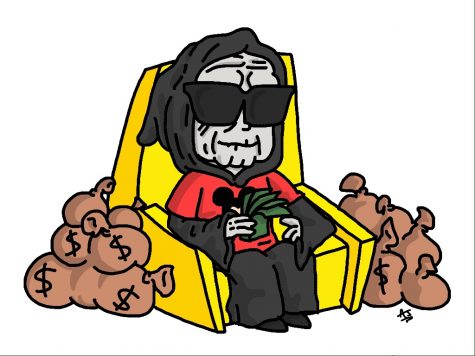
With its multi-generational span, Star Wars is now appealing to people like McLeod who saw A New Hope début at age six, and fans such as UI student Kenny Bostard, whose father grew up watching Star Wars like McLeod did.
“My dad was a child of the ‘70s, so I was pretty much forced as a child to watch Star Wars,” Bostard said. “I love it. I personally liked the original trilogy, just because it was such an important part of my childhood that I was raised off of those movies, so there’s a big nostalgia factor.”
While fans do not know what awaits them in The Rise of Skywalker, fans like Bostard do remember past controversies of the preceding film, The Last Jedi.
“It received a lot of controversy for subverting expectations,” he said. “While I personally didn’t enjoy the movie, I think it was a good thing because The Force Awakens is very much a repeat of A New Hope. I think that by changing things up, it’s trying to split itself apart from what people know and expect.”
Knipfel also has her own views on the hotly debated The Last Jedi, saying that the character of Kylo Ren, unlike what many people think, is not a new Darth Vader, but a worse Darth Vader.
“That is my entire feeling about the sequel series,” Knipfel said. “He’s a Darth Vader fanboy. The fans believe he’s deserving of a redemption arc and I 100 percent don’t.”
However, as The Rise of Skywalker ends, it is obvious to say that the Star Wars saga has resonated with millions of people worldwide and connects several generations through its original story of good and evil.
“It was telling kind of real, human stories,” McLeod said. “And people identified with good versus evil and some of the ambiguities between the two.”

(she/her/hers)
Email: [email protected]
Madison Lotenschtein is an Arts Co-Editor at The Daily Iowan. Having been with the DI since...



